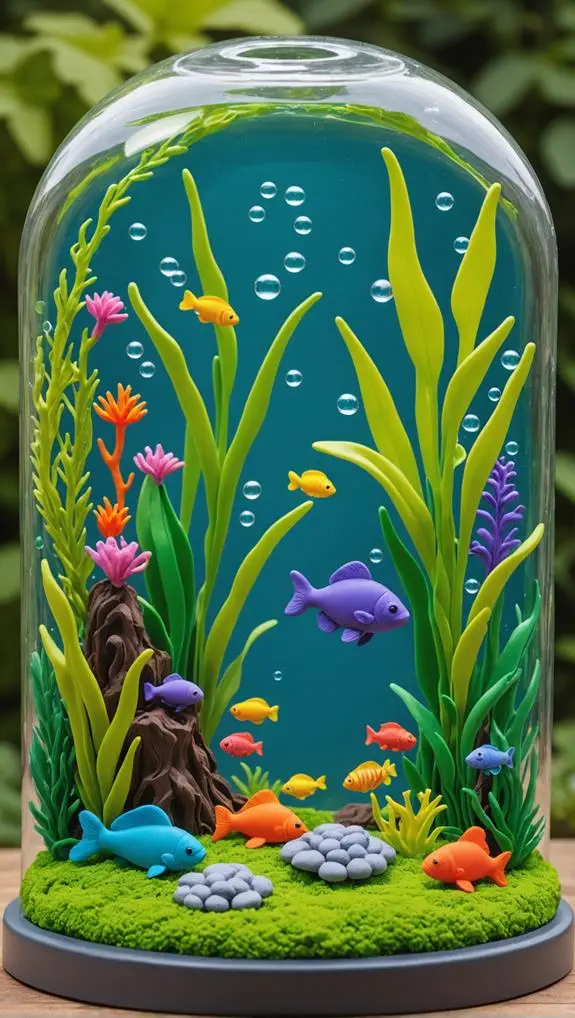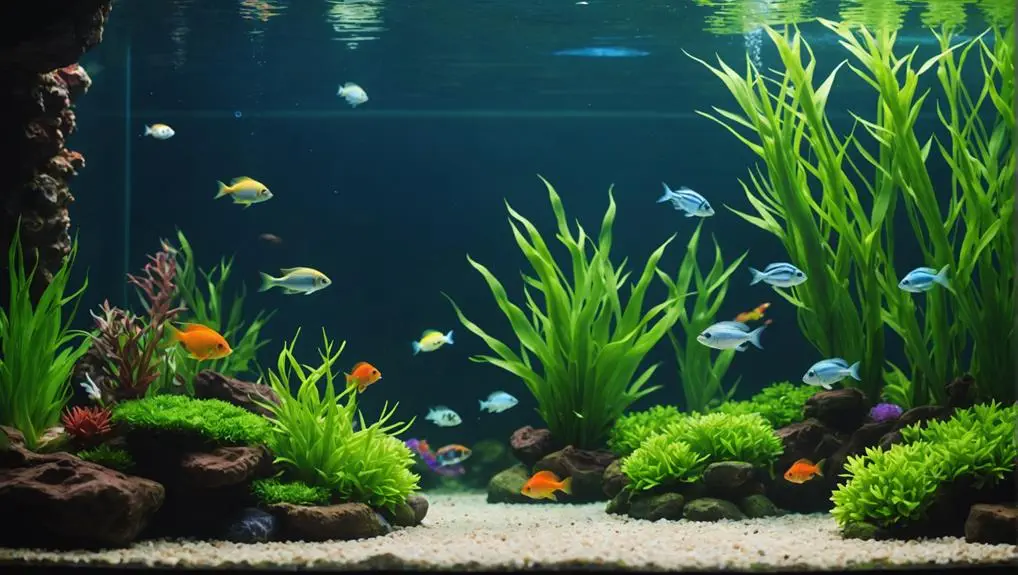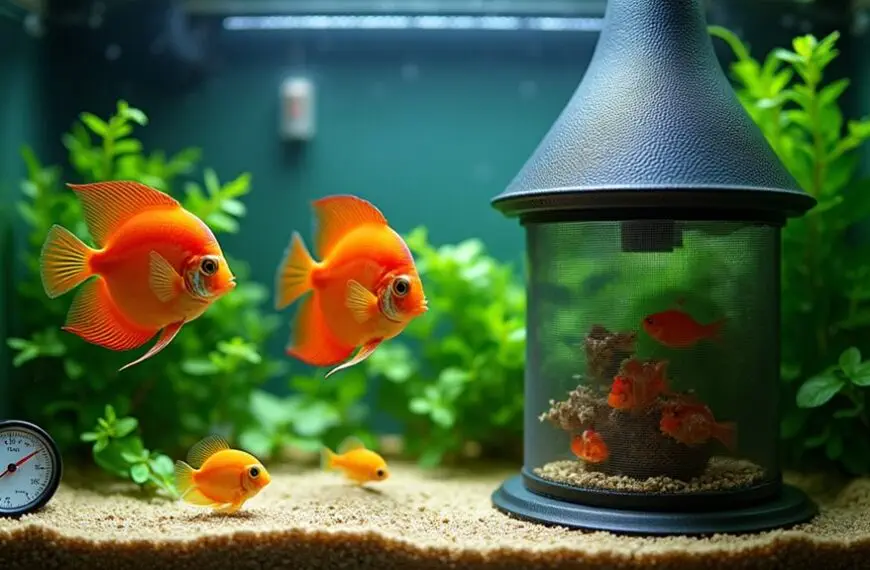Setting up a breeding tank is like giving your fish a luxury condo they can actually appreciate! It lets you control water quality, temperature, and pH, which are super important for successful breeding. Plus, a separate space means less aggression from territorial fish, creating a chill atmosphere. You'll also protect the tiny fry from becoming snacks for their parents. With a dedicated tank, you're setting the stage for healthy, happy fish families and watching those little ones thrive. So, if you want to jump into the world of breeding tanks, there's plenty more to discover!
Contents
Importance of a Dedicated Space
Creating a dedicated breeding tank is crucial for ensuring the success of your fish reproduction efforts. When you set up a breeding tank, you take control of important factors like water quality, temperature, and pH—elements that can make or break your fish's spawning success.
By establishing a stable environment through proper monitoring water parameters, you can optimize conditions for breeding. Plus, it's a fantastic way to simulate their natural habitat, complete with hiding spots and suitable spawning mediums. Your fish will feel at home, which encourages breeding like you wouldn't believe!
A smaller, isolated setup also keeps stress at bay. Less territorial aggression means happier fish, and happier fish are more likely to reproduce.
You'll also protect those precious fry by separating them from adult fish, reducing the risk of predation. Let's face it, nobody wants to witness a fry buffet!
Optimal Tank Size and Design
When it comes to setting up a breeding tank, choosing the right size and design is key to your fish's success. An ideal breeding setup typically ranges from 10 to 20 gallons. This size strikes a balance that makes it easier for you to manage breeding activities and monitor fry growth without feeling overwhelmed.
Maintaining optimal water quality is vital for the health and well-being of your fish during this crucial stage.
To create an inviting environment for your fish, consider these design elements:
- A secure lid to prevent any unexpected jumpers.
- Floating plants for egg-laying surfaces and hiding spots.
- Decorations like rocks and plants to stimulate and comfort your breeding fish.
Maintaining optimal water quality is crucial. Aim for pH levels between 6.5 and 7.5, and keep the temperature between 74°F and 80°F (23°C – 27°C). Regular water changes of 10-20% weekly are also essential.
They help prevent ammonia spikes and ensure a healthy environment for both adults and fry, making the whole breeding process smoother.
With the right tank size and thoughtful design, you're not just creating a space; you're setting the stage for successful breeding and happy fish. Plus, who doesn't want to be a fish parent?
Essential Equipment and Setup

Setting up your breeding tank is a bit like preparing a cozy nursery for new arrivals.
You'll want to pick a tank size between 10 and 20 gallons, ensuring you have enough space to monitor water quality and keep your fish happy. Regular water changes are crucial to maintain optimal water conditions for breeding, as improving water quality helps support the health of both the parents and their fry.
Plus, don't forget that sponge filter and those spawning grates, because nobody wants a fry buffet happening in your tank!
Recommended Tank Size
Choosing the right tank size is crucial for successful breeding, and a range of 10 to 20 gallons is typically ideal. This size allows for easier management of your breeding setups and helps you monitor water quality effectively. You don't want your little ones swimming in murky water!
Here are some tips to keep in mind:
- Incorporate floating plants and hiding spots to create a comfy environment for your fish. They'll appreciate having a cozy nook to call home while they're busy breeding.
- Make sure to secure lids on your tanks. Fish can be quite the jumpers, and you definitely don't want them taking a leap of faith out of the tank!
- Don't forget about regular maintenance. Clean tanks mean happy fish, and that's essential for healthy fry and adults alike.
Necessary Filtration Systems
A reliable filtration system is essential for any breeding tank to maintain a healthy environment for your fish.
When it comes to filtration systems, a sponge filter is your best friend. It offers a gentle water flow, ensuring the safety of those delicate fry while also fostering beneficial bacteria that keep the tank healthy.
You'll want to keep an eye on water quality too, so regular testing for ammonia, nitrate, and nitrite levels is a must. This helps you ensure that both adult fish and fry thrive in their cozy home.
An air pump powers the sponge filter, which can give you instant cycling if you move it from an established tank. This is a game-changer for newly spawned fry.
Using spawning grates is also a smart move; they can separate adult fish from their eggs or fry, preventing any accidental snacking.
Plus, you'll need to commit to regular maintenance routines to keep waste build-up low. Keeping your tank clean is crucial for a happy, healthy breeding environment.
Fry Safety Measures
Creating a safe environment for fry requires careful planning and the right equipment to protect them during their most vulnerable stages.
You want to ensure that your little swimmers have the best chance at life, right? Here are some key measures to consider:
- Spawning Grates: These handy tools keep adult fish away from the eggs and fry, preventing any unfortunate snacking.
- Small Sponge Filter: This gentle filter provides soft water circulation, which is perfect for tiny fry, while also supporting beneficial bacteria.
- Cover and Hiding Spots: Adding decorations like terracotta pots and plants, such as Hornwort, gives fry places to hide, helping them feel secure and reducing stress.
Don't forget to monitor water quality and perform regular water changes!
A clean environment is crucial for the health and safety of your fry. With these fry safety measures in place, you're not just protecting your fish; you're nurturing the next generation of your aquatic friends.
Water Quality Management
Maintaining optimal water quality is vital for the health and breeding success of your fish. To create a thriving environment, keep your pH levels between 6.5 and 7.5. Aim for water temperatures between 74°F and 80°F. This temperature range helps your adult fish feel comfortable and encourages successful reproduction.
Regular water changes are essential, so plan on changing 10-20% of the water weekly. This keeps ammonia and nitrate levels at 0 ppm, ensuring a safe space for both adult fish and their fry. Always use dechlorinated water for tank setups and changes; chlorine can be harmful to your fish friends.
Don't forget about water hardness! Keeping it between 4-12 dGH suits most freshwater species.
It's also crucial to monitor water quality regularly. Testing helps you spot issues before they become big problems.
Using proper filtration, like sponge filters, is a great way to maintain water clarity and health. These filters provide gentle water flow while supporting beneficial bacteria.
With a little effort, you can create a beautiful breeding tank that your fish will thrive in—just think of it as a cozy home for your aquatic buddies!
Enhancing Fry Survival Rates

How can you ensure the highest survival rates for your fry? Creating a dedicated breeding tank is your best bet. By maintaining the right water quality and temperature, you can protect those little swimmers, keeping them from getting sucked into filters or becoming snacks for adult fish.
Here are some simple steps to help you out:
- Use spawning mediums like plants or moss to give fry hiding spots. This reduces their risk of predation and helps them act naturally.
- Set up sponge filters that create gentle water movement. These filters not only keep the water clean but also host beneficial bacteria crucial for a healthy environment.
- Regularly monitor water parameters to keep ammonia and nitrates at 0 ppm. This prevents toxic buildup, ensuring your fry thrive.
Community Resources and Support
When you join a community of fellow fish breeders, you tap into a treasure trove of shared experiences and knowledge.
It's not just about celebrating your successes; it's also about learning from those little hiccups along the way.
Plus, swapping resources and tips with others can make your breeding journey a lot smoother—and who doesn't love a good fishy chat?
Community Sharing Initiatives
In a thriving breeding community, sharing knowledge and experiences is crucial for success.
You'll find that connecting with fellow hobbyists not only boosts your confidence but also enhances your breeding successes with tropical fish. Engaging in conversations helps everyone grow, and you'll quickly realize how much you can learn from one another.
Here are some ways to get involved in community sharing initiatives:
- Join discussions about breeding techniques and share your own insights.
- Check out popular resources like Greg Sage's videos or Keeping Fish Simple for inspiration.
- Participate in threads where members request and share specific breeding setups.
Resource Exchange Platforms
As you connect with fellow aquarists, exploring resource exchange platforms can significantly enhance your breeding journey.
These platforms create a vibrant community where you can share successful breeding techniques and experiences. Imagine learning from others who've been where you are, discovering tips that can boost your success!
Many forums and online groups feature threads for trading fish stock, equipment, and breeding resources. This means you can gather what you need without breaking the bank.
When you engage with local aquarium clubs or social media groups, you tap into a wealth of knowledge from seasoned breeders. They're often eager to share their insights and guide you as you set up your breeding tank.
Plus, these exchange platforms encourage collaboration on DIY projects, sparking creativity in your breeding methodologies.
You'll find that members are typically supportive, offering feedback and advice on any challenges you face. It's like having a cheer squad for your breeding endeavors!
Frequently Asked Questions
What Is the Purpose of a Breeder Tank?
A breeder tank setup enhances breeding fish care by creating a safe, controlled environment. It reduces stress, promotes successful spawning, and allows you to monitor water conditions, ensuring healthier fish populations and thriving fry development.
What's the Difference Between a Breeder Tank and a Regular Tank?
A breeder tank focuses on spawning and nurturing fry, requiring precise conditions, while a regular tank supports a diverse fish community. You'll find specialized setups in breeder tanks that aren't necessary in standard tanks.
How Big Does a Breeding Tank Need to Be?
How big does your breeding tank need to be? Ideally, it should be 10 to 20 gallons. This tank size meets breeding requirements, making it easier for you to monitor spawners and ensure fry survival.
What Are the Benefits of Having a Fish Tank in Your Home?
Having a home aquarium offers numerous fish tank benefits. It reduces stress, enhances air quality, promotes responsibility, and creates a beautiful centerpiece. Plus, it sparks conversations, enriching your environment and serving as a delightful experience for everyone.
Final Thoughts
Setting up a breeding tank is like building a cozy nest for your fish family. It gives them a safe space to thrive and grow, just as a warm home does for us. With the right setup, you ensure your fry have the best chance of survival, and you'll have the satisfaction of watching them flourish. Plus, connecting with fellow fish enthusiasts can make the journey even more enjoyable. So, dive in and start creating that perfect breeding environment!












